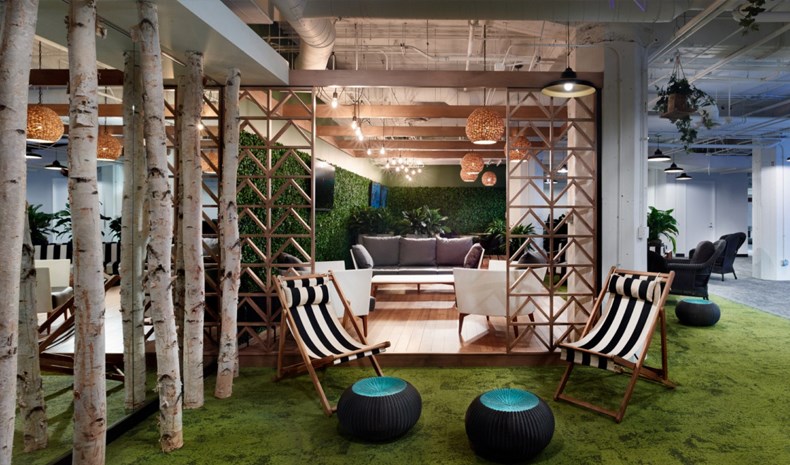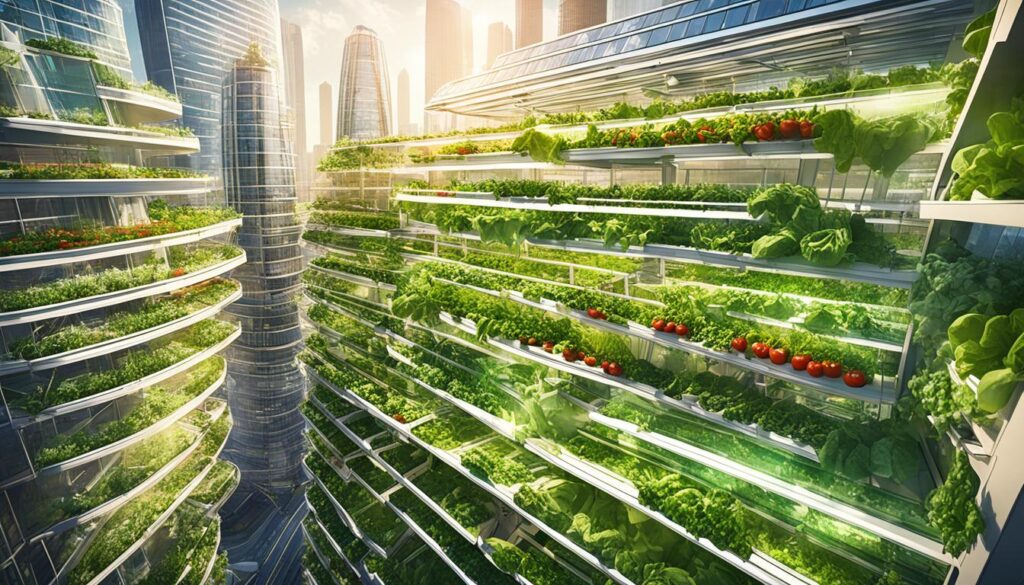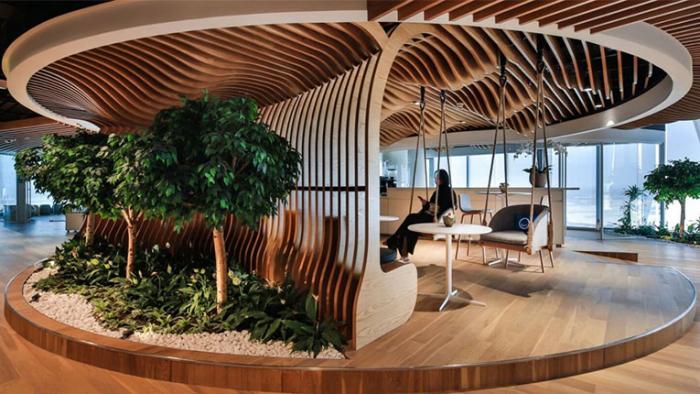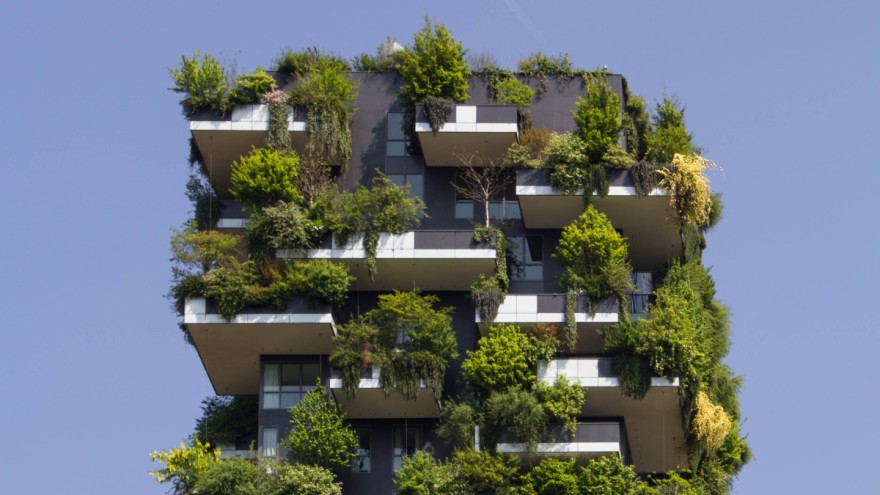Sustainable Materials for Indoor Biophilic Features.
Incorporating sustainable materials into indoor biophilic design is crucial for creating environments that foster a connection with nature while promoting environmental responsibility.
This article examines the significance of utilizing sustainable materials, with a focus on examples such as recycled, natural, and low VOC options, which are integral to green building practices. It addresses the advantages these materials provide for human health, occupant well-being, and the planet, in addition to enhancing aesthetic appeal through nature-inspired design.
Furthermore, the article offers practical guidance for selecting and integrating sustainable materials into biophilic features and indoor ecosystems, aiding in the transformation of indoor spaces into healthier and more visually appealing environments with improved air quality and urban biodiversity.
Why Are Sustainable Materials Important for Indoor Biophilic Features?
.jpg_00.jpeg)
Sustainable materials are essential in the implementation of indoor biophilic features, as they strengthen the connection between occupants and the natural environment while also promoting health and wellness within indoor spaces.
By incorporating sustainable materials, such as reclaimed wood, bamboo, and other renewable resources, architects and designers can develop environments that respect ecological considerations, improve air quality, and enhance the overall user experience through sustainable architecture and wellness-oriented design.
These materials are critical in fostering indoor ecosystems that support biodiversity, energy efficiency, and social sustainability, all while minimizing the ecological footprint and promoting design efficacy in construction projects.
What Are Some Examples of Sustainable Materials for Biophilic Features?
Sustainable materials suitable for biophilic features encompass recycled materials, natural options such as wood and bamboo, and low VOC materials that promote healthier indoor environments.
These materials are not only environmentally friendly but also enhance the aesthetic appeal of spaces by embodying the principles of biophilia through natural textures and patterns.
The meticulous selection of these materials, which includes organic shapes, non-toxic finishes, and sustainable sourcing, ensures that design choices are in alignment with sustainability objectives while enriching the overall sensory experience and acoustic comfort of indoor spaces.
1. Recycled Materials
Recycled materials are fundamental to sustainable design, as they significantly reduce environmental impact by diverting waste from landfills and promoting a circular economy. The use of recycled materials, such as reclaimed wood or recycled plastics, not only minimizes resource consumption but also exemplifies innovative design and craftsmanship that underscores the importance of responsible manufacturing practices.
Incorporating these materials within biophilic design enhances the overall aesthetic appeal of a space, allowing natural textures, organic shapes, and colors to emerge, which can foster a sense of connection to the environment and promote psychological well-being. This approach not only creates a visually inspiring atmosphere but also promotes wellness and comfort, making it a suitable choice for both residential and commercial spaces.
By prioritizing recycled elements, designers support sustainability initiatives and encourage a culture of environmental stewardship that resonates with eco-conscious consumers.
2. Natural Materials
Natural materials such as wood and bamboo play a crucial role in biophilic design, as they facilitate a profound connection between indoor environments and the natural world. These materials not only provide durability and aesthetic value but also contribute to indoor air purification and thermal comfort. This makes them essential elements of healthy buildings that prioritize user experience and well-being.
Incorporating these elements into design allows for the creation of spaces that enhance emotional well-being and promote relaxation. The inherent warmth of wood and the distinctive textures of bamboo foster a sense of harmony, resulting in environments that are both inviting and restorative.
Utilizing such natural resources and adapting design principles can significantly reduce stress levels and enhance productivity by emulating the calming effects of nature and improving psychological well-being. Ultimately, the integration of these materials not only beautifies a space but also nurtures the overall psychological health of its occupants, reinforcing the critical connection between our environments and our mental state.
3. Low VOC Materials
Low VOC materials are essential for the development of healthy indoor environments, as they significantly enhance air quality, reduce indoor air pollution, and contribute to the overall well-being of occupants. By utilizing materials with low volatile organic compounds, such as certain paints and finishes, designers can minimize harmful emissions, promote mindfulness, and create spaces that support restorative environments.
This deliberate choice not only mitigates the risk of respiratory issues and allergies but also aids in the creation of more sustainable living spaces. Health-focused designs that integrate low VOC options are increasingly acknowledged for their role in fostering a connection between individuals and nature, thereby promoting psychological well-being.
Along with the immediate health benefits, the adoption of such materials facilitates the creation of tranquil environments where occupants can thrive, experience deeper relaxation, and achieve reduced stress levels. The interplay between biophilic design and low VOC materials underscores the critical necessity for healthier indoor spaces that address both the physical and mental health needs of their users.
How Do Sustainable Materials Benefit Indoor Biophilic Features?
Sustainable materials offer a range of advantages for indoor biophilic features, including a reduced environmental impact, improved health and well-being, and enhanced aesthetics.
By employing eco-friendly materials and responsibly sourced materials, designers can create environments that foster a connection to nature while also supporting indoor ecosystems that promote biodiversity, energy conservation, and thermal comfort.
Furthermore, these materials play a significant role in improving air quality and enhancing the overall user experience, making them essential components of wellness architecture.
1. Reduces Environmental Impact
.jpg_01.jpeg)
One of the primary advantages of utilizing sustainable materials is their capacity to substantially reduce environmental impact, thereby supporting principles such as the circular economy and minimizing ecological footprints. By selecting materials that are responsibly sourced and possess a lower carbon footprint, designers can contribute to a more sustainable future while fostering healthier indoor environments.
For instance, the incorporation of reclaimed wood not only mitigates deforestation but also makes use of existing resources, thereby reducing waste. It is estimated that the use of reclaimed materials can decrease energy consumption by up to 85% compared to new materials.
Similarly, materials such as bamboo, which grows rapidly and sequesters carbon, present an environmentally friendly alternative to traditional hardwoods.
Statistics indicate that the construction industry is responsible for approximately 39% of global carbon emissions; therefore, transitioning to sustainable options and embracing climate-responsive design can play a crucial role in addressing climate change.
Ultimately, by making informed choices regarding materials, various sectors can significantly enhance environmental health and further advance sustainability.
2. Promotes Health and Well-being
Sustainable materials significantly contribute to health and well-being by enhancing indoor air quality and creating environments that support emotional and psychological benefits. The incorporation of natural materials and low VOC finishes allows designers to cultivate restorative spaces that enhance the overall well-being of occupants while fostering a more mindful connection to their surroundings.
Research demonstrates that environments enriched with sustainable materials can substantially decrease the presence of allergens and toxins, resulting in fewer respiratory issues and improved mental clarity. For example, the use of bamboo flooring or reclaimed wood not only adds aesthetic value but also reduces harmful emissions typically associated with conventional materials.
Studies indicate that spaces designed with sustainability in mind are effective in lowering stress levels, as the natural textures, light quality, and colors of these materials evoke a sense of calm and a connection to nature. This holistic approach promotes healthier living environments that benefit both physical and mental health, ultimately encouraging a lifestyle centered around wellness.
3. Enhances Aesthetics
The utilization of sustainable materials significantly enhances the aesthetics of biophilic design by integrating natural textures, colors, and patterns that foster visual connections with nature, while also enhancing the overall sensory experience and aesthetic sustainability. This design approach not only elevates the sensory experience but also enhances the overall appeal of indoor spaces, rendering them more inviting and harmonious.
For example, reclaimed wood can add warmth and character to modern interiors, while organic fabrics and sustainable textiles provide a sense of softness and a tactile experience that resonates with occupants. Green walls featuring live plants not only purify the air but also act as striking focal points, promoting a sense of tranquility. Moreover, the innovative use of bamboo reinforces sustainability while introducing an elegant simplicity that complements contemporary design aesthetics.
By prioritizing these environmentally friendly choices, designers can evoke more profound emotional responses, creating spaces that feel vibrant and deeply connected to the surrounding ecosystem.
What Are Some Tips for Choosing Sustainable Materials for Biophilic Features and Enhancing Environmental Sustainability?
Selecting sustainable materials for indoor biophilic features requires a strategic approach that encompasses comprehensive research, product evaluation, and consultation with experts in sustainable sourcing and renewable resources.
By gaining a thorough understanding of the life cycle of materials and their environmental impact, designers can make informed decisions that align with sustainability objectives while simultaneously enhancing indoor environments and promoting environmental sustainability.
1. Research and Compare Products
Thorough research and comparison of products are critical steps in the selection of sustainable materials, ensuring that designers opt for eco-friendly materials that fulfill both functional and aesthetic appeal requirements.
By assessing material performance, sustainability certifications, and sourcing practices, professionals can make informed decisions that align with their project objectives.
Utilizing reputable resources, such as industry reports, peer-reviewed journals, and dedicated sustainability websites, can enhance the understanding of the environmental impacts associated with various materials including their ecological impact and carbon footprint.
Establishing connections with suppliers who prioritize transparency in their practices is essential, as it provides clearer insights into their resource procurement and manufacturing processes.
Participating in online forums and communities can also offer valuable firsthand experiences from other professionals, thus enriching the understanding of product effectiveness and resource conservation strategies.
Ultimately, the integration of comprehensive research and the utilization of these valuable resources give the power tos designers to select the most sustainable materials that meet both their creative and ecological goals.
2. Consider the Life Cycle of Materials
Considering the life cycle of materials is essential for comprehending their long-term environmental impact and sustainability. By analyzing the production, usage, and disposal processes, designers can select materials that contribute positively to the circular economy and minimize the ecological footprint of their projects.
This approach not only facilitates well-considered choices but also promotes the use of renewable resources, recyclability, and overall energy efficiency, which are key components of a regenerative design.
For instance, when designing packaging solutions, a comprehensive life cycle assessment (LCA) may reveal that biodegradable products, despite incurring higher initial costs, significantly reduce harmful emissions during disposal compared to conventional plastics.
Similarly, in the construction industry, the selection of locally sourced materials can decrease transportation emissions while simultaneously supporting the local economy.
Ultimately, the integration of life cycle assessment into material selection is crucial for fostering innovation, enhancing product performance, and promoting sustainable development across various industries.
3. Consult with Experts
.jpg_10.jpeg)
Consulting with experts in sustainable sourcing and material selection significantly enhances the decision-making process, ensuring that designers remain informed about the latest innovations and best practices in eco-conscious design. Insights from these professionals can provide valuable guidance in selecting materials that align with sustainability objectives and project requirements.
Furthermore, collaborating with industry professionals grants access to extensive resources and networks that can elevate a project’s sustainability profile. These experts typically have access to cutting-edge research, industry benchmarks, and a wide array of sustainable material options that may not be readily available to the average designer.
Establishing partnerships with specialists can facilitate connections to vetted suppliers committed to eco-friendly practices, thereby ensuring that both quality and intent are upheld in the sourcing process. By leveraging this knowledge and community, designers can make informed choices that prioritize environmental considerations while appealing to an increasingly conscious consumer base.
How Can We Incorporate Sustainable Materials into Indoor Biophilic Design?
The incorporation of sustainable materials into indoor biophilic design can be effectively achieved through several strategies, including the integration of green walls, the optimization of natural lighting, and the use of sustainable furniture and decorative elements.
These methods not only contribute to improved urban biodiversity but also enhance the overall user experience by fostering restorative environments that facilitate a connection between occupants and nature.
1. Green Walls and Vertical Gardens
Green walls and vertical gardens serve as exemplary features within biophilic design, enhancing indoor biodiversity and fostering a closer connection to nature. These living installations not only improve air quality through effective indoor air purification but also contribute to the aesthetic appeal and dynamic sensory experience of indoor environments.
Beyond their visual and environmental advantages, these vertical installations can also play a significant role in energy efficiency and thermoregulating materials by providing insulation, thereby reducing heating and cooling costs.
It is imperative to carefully consider factors such as the selection of plant species, which should be appropriate for the specific light and humidity conditions of the environment. Regular maintenance practices, including irrigation and pruning, are essential for ensuring the longevity and health of the plants, ultimately determining the success of integrating green walls and vertical gardens into any space.
2. Natural Lighting and Ventilation
Maximizing natural lighting and ventilation is a fundamental principle of sustainable design that significantly enhances energy efficiency and supports occupant well-being. By strategically positioning windows and employing design techniques that promote daylighting, designers can create environments that are both inviting and seamlessly connected to the outdoors.
Natural lighting reduces dependence on artificial sources, consequently lowering energy consumption, while also fostering positive impacts on mood and productivity. For example, the incorporation of large skylights or clerestory windows allows ample sunlight to illuminate interior spaces, creating a tranquil atmosphere.
Additionally, features such as operable windows facilitate ventilation, enabling fresh air circulation, which can greatly improve indoor air quality.
The use of materials such as light-colored walls and reflective surfaces can further enhance this effect, establishing a harmonious relationship between nature and architecture. These strategies not only elevate aesthetic appeal but also contribute to the creation of healthier, more sustainable living environments.
3. Use of Sustainable Furniture and Decorations
The incorporation of sustainable furniture and decorations enhances biophilic design by promoting eco-friendly products that improve both functionality and aesthetics. By selecting furnishings constructed from natural materials and crafted with care, spaces can be transformed into more inviting and harmonious environments while demonstrating a commitment to sustainability.
Choosing materials such as reclaimed wood, bamboo, or recycled metals not only helps to reduce waste but also ensures that these pieces are durable and long-lasting. Furthermore, opting for furniture that employs low-VOC paints and finishes can contribute to healthier indoor air quality.
In terms of design styles, embracing minimalist, Scandinavian, or mid-century modern aesthetics with an environmentally conscious approach can create a timeless appearance that appeals to individuals who prioritize sustainability.
Ultimately, making deliberate choices regarding both material selection and design style can result in a thoughtfully curated space that aligns with the principles of sustainable living and wellness-oriented design.
Frequently Asked Questions
What are sustainable materials for indoor biophilic features?
.jpg_11.jpeg)
Sustainable materials for indoor biophilic features are materials that are environmentally friendly, non-toxic, and responsibly sourced. They are also durable, contribute to energy conservation and have a low impact on the environment and ecological footprints.
Why is it important to use sustainable materials for indoor biophilic features?
Using sustainable materials for indoor biophilic features is important because it helps to reduce the negative impact on the environment and supports environmental sustainability. It also promotes a healthier indoor environment and supports responsible and ethical production practices.
What are some examples of sustainable materials for indoor biophilic features?
Some examples of sustainable materials for indoor biophilic features are bamboo, cork, reclaimed wood, recycled glass, and organic fabrics. These materials are renewable, recyclable, and have a lower carbon footprint compared to traditional materials, contributing to regenerative design and nature-inspired design.
How do sustainable materials for indoor biophilic features contribute to a biophilic design?
Sustainable materials for indoor biophilic features contribute to a biophilic design by mimicking elements of nature in the indoor space. This creates a connection to the natural world and promotes a sense of wellbeing.
Are sustainable materials for indoor biophilic features more expensive?
Sustainable materials for indoor biophilic features can be more expensive initially, but they tend to have a longer lifespan, reducing the need for frequent replacements. They also have lower maintenance costs and can help reduce energy consumption in the long run.
Can I use sustainable materials for indoor biophilic features in any indoor space?
Yes, sustainable materials for indoor biophilic features, such as wood, bamboo, and cork, can be used in any indoor space, whether it’s a residential or commercial setting. They are versatile and can be incorporated into various design styles to create a biophilic environment that enhances occupant well-being and promotes environmental sustainability. By utilizing renewable resources and eco-friendly materials, these spaces benefit from incorporating natural light and indoor plants, thereby improving air quality and energy efficiency. Additionally, elements like living walls, recycled materials, and low VOC paints contribute to a nature-inspired design that prioritizes human-centered design and the human-nature connection. This approach not only reduces the carbon footprint but also fosters ecological impact and supports sustainable lifestyles.

I’m Bruno, an architect with a deep passion for Biophilic Design in Urban Architecture. Throughout my career, I’ve focused on integrating natural elements into urban planning, and I created this site to share my insights and foster a deeper understanding of how biophilic principles can significantly enhance urban living. Dedicated to sustainable development, I continually explore innovative design solutions that promote both environmental and human well-being in city landscapes.














Publicar comentário